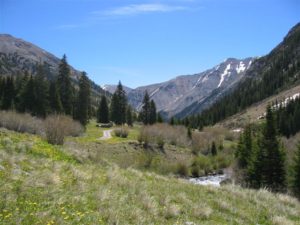Hinsdale County
Burrows Park District (aka Whitecross District; aka Park District)
This district is possibly an amalgamation of several districts, but at least has several names. Henderson provides very a very specific location for the Park District, listing 16 sections in three different townships that appear to be the same as other descriptions of the Whitecross/Burrows Park District. Dunn (2003) indicates that the Burrows Park District may have originally been known as the Park District, which seems to fit with Henderson’s description. She notes that Hinsdale County was divided into six districts by the state legislature in 1893, of which the Park District was one, along with the Carson, Cimarron, Galena, Lake, and Sherman Districts. Mindat.org (Sep 2015) considers the Burrows Park, the Park and the Whitecross to be the same district, a convention we follow here.
Vanderwilt (1947) considered the Burrows Park District, which he described as sitting at the head of the Lake Fork of the Gunnison River, to be a continuation of the mineralization of the Silverton area. Wilson and Spanski (2004) aggregated the Burrows Park District in with eight other districts as the “San Juan Mineralized Area.” The connection is that they appear to lie within the San Juan caldera of Steven and Lipman (1976). (The other districts in this grouping are the Galena/Henson Creek, the Sneffels, South Ouray, Eureka, Telluride, Ophir, Red Mountain and Lower San Miguel, of which the Galena is in Hinsdale County.)
The geology consists of tuffs and flows associated with the Oligocene San Juan caldera complex, with an outlier of Precambrian granites in the middle (Vanderwilt, 1947). Mineralization consists of “filled fissures grading into replacement types” of chalcopyrite ore, sphalerite-galena ore or gold-silver ore with small amounts of lead and zinc (Vanderwilt, Ibid).
Eberhart (1969) discusses the three settlements that arose around Cinnamon Pass – Whitecross, Tellurium and Sterling. He indicates that the harsh winters and associated transportation problems inhibited both the mines and the towns.
Mines listed in the district (mindat.org; Eberhart, 1969; Dunn, 2003) include:
Allen Dale2
Bon Homme Tunnel1, 2
Burrows Park Group1
Champion2
Cleveland Group (Hilluron Millsite; Ida; Lock Lommond)1
Cracker Jack2
Dewey1
Gavin Pipe Occurrence1
Gnome Mine (Bull Run; Bull Run No. 1; Unpatented Claims: Sydney Nos. 1-3;
Gnome Nos. 1-26; Patented Claim: Gnome)1
Goodwin1
Goodwin’s Creek1
Illinois Boy Mine (Patented Claim: Illinois Boy)1
Isolde Mine (Belcher; Baltimore; Isolde)1
Little Sarah2
Monticello Mine1
Mountain King2
Napoleon Mine (Patented Claim: Napoleon)3
Ohio Mine1
Onida3
Park View Mine (View of the Park Mine; D & N Lead Mining Company Nos. 1-4)1
Providence2
Seward County Mine (Patented Claim: Seward County)1
Silver Star Mine (Patented Claim: Silver Star)1
Tobasco2
Troy2
Undine3
Whitecross Mountain1
Notes: 1 Mines listed in mindat.org, September 2015.
2 Mines listed by Eberhart (1969), as located near the settlements around Cinnamon Pass.
3 Mines listed by Dunn (2003).
Minerals listed in the district (mindat.org) include:
Brochantite
Calaverite
Calcite
Chalcopyrite
Galena
Lillianite
Molybdenite
Opal var: Opal-AN
Platinum
Pyrite
Quartz
Sphalerite
Tetrahedrite
References:
Dunn, Lisa. 2003. Colorado Mining Districts: A Reference. Colorado School of Mines, Golden, Colorado.
Eberhart, Perry. 1969. Guide to Colorado Ghost Towns and Mining Camps. Fourth, revised edition. Swallow Press, Athens, Ohio.
Henderson, C.W. 1926. Mining in Colorado, a history of discovery, development and production. U.S. Geological Survey Professional Paper 138.
Steven, T.A. and Lipman, P.W. 1976. Calderas of the San Juan Volcanic Field, Southwestern Colorado. U.S. Geological Survey Professional Paper 958.
Vanderwilt, John W. 1947. Mineral Resources of Colorado. Colorado Mineral Resources Board, Denver, Colorado.
Wilson, A.B. and Spanski, G.T. 2004. Distribution of Mines and Mineralized Areas in Bankey, V., ed. Resource Potential and Geology of the Grand Mesa, Uncompahgre, Gunnison National Forest and Vicinity, Colorado. U.S. Geological Survey Bulletin 2213.
www.mindat.org, accessed September 2015.
This information is from the Colorado Geological Survey website at http://coloradogeologicalsurvey.org





